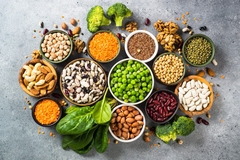
- Industry news
Industry news
- Category news
Category news
- Reports
- Key trends
- Multimedia
- Journal
- Events
- Suppliers
- Home
- Industry news
Industry news
- Category news
Category news
- Reports
- Key trends
- Multimedia
- Events
- Suppliers
Marketing Intensifies for Traffic Light Labelling

A series of TV advertisements raising awareness of traffic light colour-coded front of pack food labels is airing on British terrestrial television. Other marketing activity will feature in the press, on poster sites and via the Internet.

17/01/07 The UK Food Standards Agency has launched the next stage of its continuing activity to make it easier for people to make healthier food choices.
A series of TV advertisements raising awareness of traffic light colour-coded front of pack food labels – researched and developed by the FSA is airing for the first time on British terrestrial television. Other marketing activity to accompany the TV work will feature in the press, on poster sites and via the Internet.
Labelling complex foods such as ready meals, pies and pizzas with clear and honest nutritional information is an important step in helping to improve the nation’s diet. The FSA’s recommendations for nutritional labelling are based on robust, published consumer research and extensive consultation. Research showed clearly that traffic light colour-coding was key in helping shoppers choose healthier products quickly and easily.
The quirky 10-second TV ads, which each have a slightly different twist, reflect the straightforward and easy to use nature of traffic light labelling, with a red light meaning the product is high in fat/saturated fat/sugar/salt, an amber light meaning medium and a green light meaning low.
A recent Agency tracking survey conducted by RSGB with a representative sample of circa 2000 UK adults in January 2007 showed that shoppers clearly understand this approach. About 76% of those asked interpreted a red light on a product as meaning the food is high in something that we should be trying to cut down or keeping on eye on – only 16% interpreted it as meaning it is unhealthy and shouldn’t be eaten at all.
Food Standards Agency Chair Deirdre Hutton, says: ‘Most manufacturers and retailers are now using front of pack nutritional labelling and this is good news. Some shoppers find extra GDA information useful – and all industry needs to do is add traffic light colours to their GDA schemes to ensure the consumer gets the best of both worlds.
‘Our extensive and published research demonstrates that the use of traffic light colours is key in helping people interpret nutritional information on foods. We want to highlight to shoppers that these labels are now out there and really can help us all to make healthier choices.
‘Our new labelling TV ads, like the traffic light approach, are clear and simple – with the beauty being that these labels speak for themselves.’
Many health charities and consumer organisations support the Agency’s approach to nutritional food labelling. The most recent new supporter to add its voice is the Royal College of Physicians. President of the Royal College of Physicians, Professor Ian Gilmore, commented: ‘Obesity and unhealthy eating are a real and serious threat to the health of individuals and the nation. The complex nature of this threat requires a clear and coherent strategy – the Royal College of Physicians welcomes the FSA’s approach to front of pack labelling as a most necessary and practical element of such a strategy.’
Traffic light colour-coded labels have been adopted by a range of retailers and manufacturers that are all keen to show openly and honestly what is contained in their food products, in order to help their customers make healthier choices.
Recent adopters of the approach include: Asda, M&S, Budgens/Londis, Avondale Foods, Moy Park, Bombay Halwa and S&B Herba. They join Sainsbury’s, Waitrose, Co-op, McCain and New Covent Garden Food Co, which have all been using colour-coded schemes for some time.











